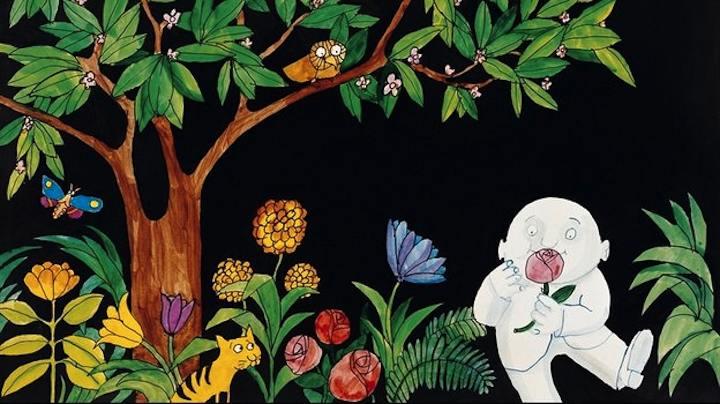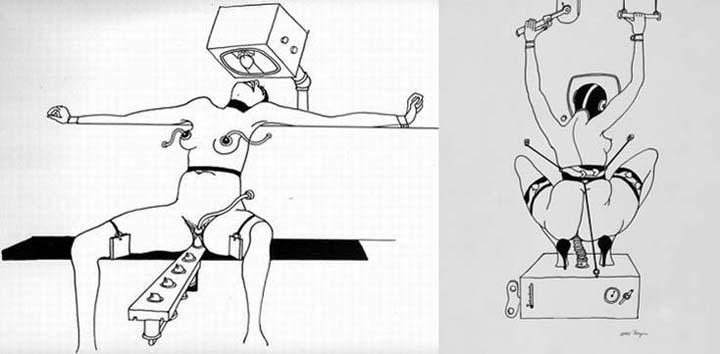Tomi Ungerer,The Subversive Child: Part II
From Part I of this feature: The renowned author-illustrator Maurice Sendak was a great friend of Tomi’s, and both were helped by Harper & Row’s editor Ursula Nordstrom, who allowed them to break the rather conservative rules in children's books publishing back in the late 1950s.Tomi had arrived in New York in 1956 with $60 in his pocket and a trunk full of drawings; a year and a half later he had already published his first book "The Mellops Go Flying" (1957). Sendak once said his best-known book, "Where the Wild Things Are", could exist, in part, thanks to the talent and spirit that Tomi had brought to children's literature: "... he allowed for children in American to be dealt with like the intelligent creatures that we know they are,” he said.
His children’s books were followed by ad campaigns for Pepsi, The New York Times and TWA, editorial illustrations for the most prestigious magazines and even TV commercials, throwing him into a kind fame like a tornado.

Soon came the Vietnam War and Tomi could not tolerate the idea that it would happen again after the atrocities he had witnessed as a boy. So, in a single day that anger served as a huge source of inspiration; he started and finished a series of anti-war posters that would mark the minds of millions of people forever. "The war taught me to understand absurdity, such as when the French liberated us from the Germans and then they themselves were the ones who were responsible for burning all the books in the library, doing what one would have expected from the Nazis. Reality tends to be absurd, they are more or less the same because everything is relative: If you put an ant next to a puddle, then it’s a big pond."
In ‘67 "Fornicon" comes out, a book of erotic satire that explicitly illustrates the mechanical sex in America as a mockery of society’s languished behavior. Soon after it’s followed by "Totempole", with only women in sadomasochistic situations, using a more eclectic style. Tomi grew up in a 100% Puritarian environment, therefore the sexual edge to his work flourished somewhat later in his life, but once it came out it did so without limit. "One day I met a girl who was looking for a job. She had seen an erotic film and now needed a man to hire her to be his slave. I was delighted to take her in and many of my bondage drawings came out of it."

Anyhow, it was not long before someone noticed Tomi’s opposites: "Everything happened in one night. I was invited to speak at a book convention and someone from the audience attacked me because I was doing children’s and erotic books, to which I replied that if people did not have sex there wouldn’t be any children to begin with. It was the worst thing I could have said. Kids know where they come from, they are not stupid; what I do not know is where adults come from."
Overnight, Tomi became a sort of public enemy, "Being on his side was to be on the wrong side," reflected Sendak. Among many others, even The New York Times Book Review editor refused to review Tomi’s books. They were banned from all libraries in the country and taken out of print. The seventies marked the abrupt end of his moment of glory in the United States, and in 1971 he moved with his wife to Nova Scotia, Canada. When he summarizes his love-hate relationship with America, Tomi concludes: "There is no humor without despair. My erotic work never bothered anyone in Europe, but in America the policies are bad, they get into everyone's business and tell them how to live their lives. It’s not my cup of tea."
When Tomi and his third wife Yvonne decided to have a family, in 1976, they moved to Ireland and raised three children. They fell so in love with both its beauty and its history that they never left. It took 23 years for Tomi to finally go back to the endeavor that had treated him so well, but had also so easily rejected him. The book was “Flix,” the story of a couple of cats who have a dog baby, with all the contradictions that entails, and how they manage to go on; a clear analogy about the union of races in the world of humans.Time usually comes along with wisdom, and Flix seems to show a different source of inspiration in the author's life. "Although there are many scary things in my books, to balance that aspect the kids in my stories are never scared. It's part of my autobiography, because when I went through the war as a kid I don’t remember my mother being afraid. […] I never took my children's books too seriously, it was rather to forget about all the rest. When I went back into children’s books I did it with a very different purpose.” Which definitely made a difference, because the following year Flix received the Pulitzer Prize of children's books, the Hans Christian Andersen Award.

Photo by Stephan Vanfleteren for Du magazine
One of Tomi’s phrases that resonates the most throughout the years is that kids should be traumatized if you want to give them an identity, auto-labeling himself the nightmare of any pedagogue. "My life is a fairy tale with all its monsters, it’s essential to know your own demons"- says confidently in the documentary about his life, "Far Out Is not Far Enough" launched by Corner Cave of the Media in 2012. Along with this line of thought, the protagonists of his stories tend to be marginal, presenting unexpected heroes in a reality that belongs more to Dr. Seuss’ Christmas Grinch than to Snow White and the Seven Dwarfs. "I’ve always made sure to do whatever I felt like." It’s the most rational explanation we can find to decipher his formula for a success sometimes a little too custom-made.
Tomi’s work is characterized by ink and nib on paper, taking over the sheet to give it what he calls its first life; once a project is edited it’s the second life; and the third and final life is when your work reaches the hands of the spectator. This notion of an active interaction with the audience has always made Tomi a bit anxious. "I never liked my work,” he said, “but it's different when I write, I’m proud of it. It’s better that way though because I always keep trying and trying in order to improve. In the last 3-4 years is the first time I 'm happy with what I do. When my museum opened in Strasbourg (Musée Tomi Ungerer, 2007) I could finally see that it wasn’t so bad after all. What happens is that I get bored easily, I'm very restless, I have too many ideas and with age it only gets worse. It snowballs and I’m crushed by it." He says so as if it were obvious that as you get older you actually have more ideas. In that case, let the party continue, my dear Tomi, the audience is asking for more.
Tomi Ungerer: All in One, continues through March 22 at The Drawing Center, 35 Mercer Street, New York, NY.
Tonight at 8 pm, there will be a screening of Far Out Isn't Far Enough: The Tomi Ungerer Story (Dir. Brad Bernstein) at the IFC Center. 323 Avenue of the Americas, NY, NY. Tickets.On Thursday, February 26th, there will be a screening of Far Out Isn't Far Enough: The Tomi Ungerer Story (Dir. Brad Bernstein,) at The Drawing Center. Information.
Tomi Ungerer was born in Strasbourg in Alsace in 1931. He has lived and worked in Strasbourg, New York, Canada and Ireland and his work has been widely acclaimed with numerous honors and awards, including Legion d'Honneur France (1990); Order of the Deutsches Bundesverdienstdreuz, Germany (1993); National Prize for Graphic Arts France (1995); Hans Christian Andersen Prize for children's literature (1998); European Prize for Culture (1999); Officer of the Legion d'HonneurFrance (2000); Named Goodwill Ambassador for Childhood and Education of Council of Europe (2003); Erich Käistner Literary Prize (2004); Awarded an honorary Doctorate in Philosophy from the University of Karlsruhe (2004). [more]
Fernanda Cohen is a multiple award-winning illustrator who splits her time between New York & Buenos Aires. She graduated from the School of Visual Arts in 2004. Some of her high-profile projects ever since include illustrating a bottle for Coca-Cola, a series of murals for American Express, designer T-shirts for The Gap, the cover of the New York Times Magazine and editorial pieces for The New Yorker, Fast Company and Time among many others. She’s a longtime DART contributor and has also been writing an illustration column for Argentine magazine 90+10
Read Tomi Ungerer,The Subversive Child Part I here. Please Note correction to byline: Fernanda Cohen.


